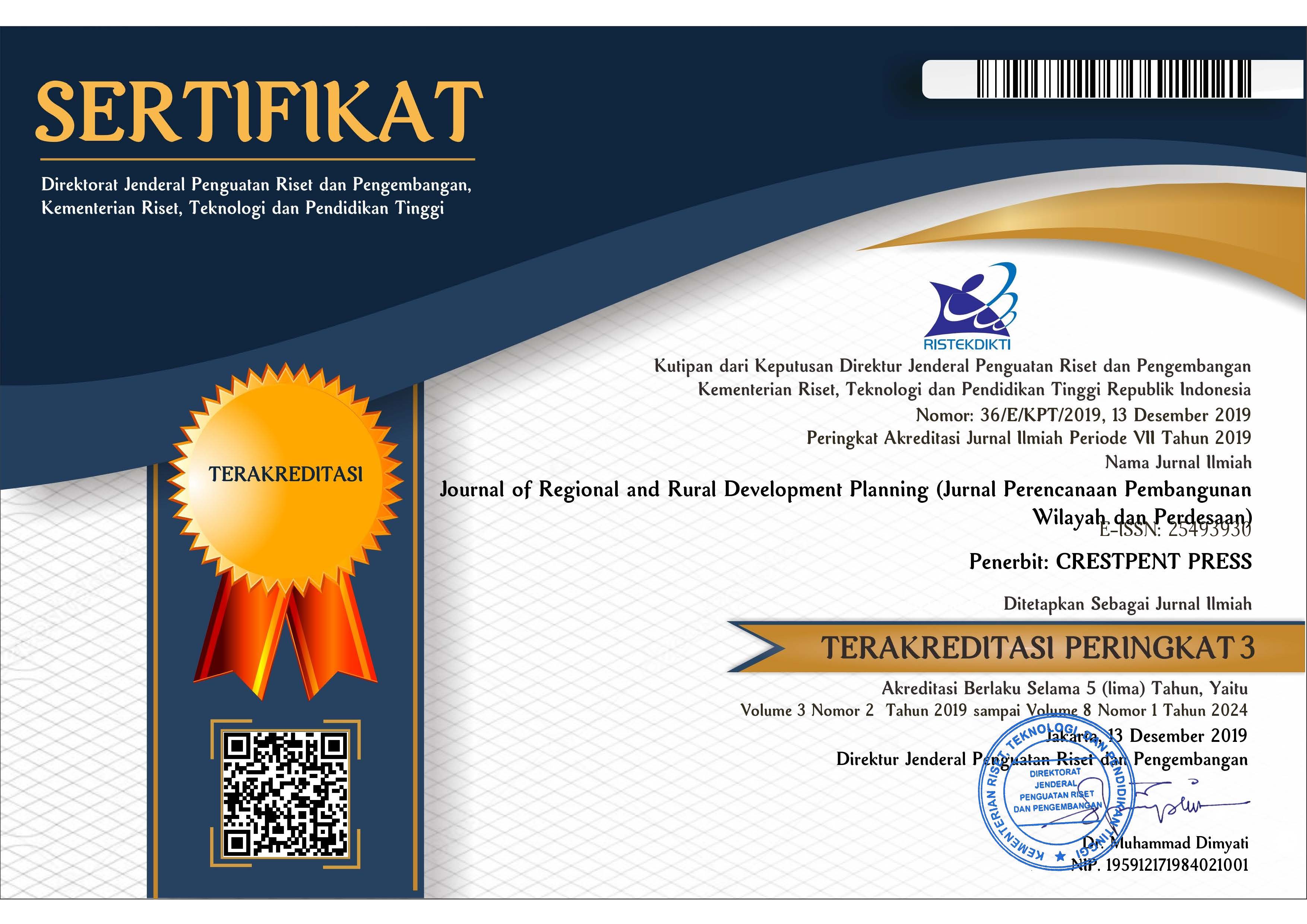Causing Factors of Urban Sprawl Symptoms in Peri-Urban Areas of Singaraja City, Bali Province
DOI:
https://doi.org/10.29244/jp2wd.2021.5.3.134-142Keywords:
leap-frog development, peri-urban, urban sprawlAbstract
The development of a city is marked by an increase in population and an increase in the need for space, which causes the city to be unable to accommodate its activities. Hence, physical development of the city to the peri-urban area and urban sprawl occurs. This also happened in Singaraja City, Bali province as proved by the increasing development of settlements in the area. The purpose of this research is to identify the development of Singaraja City spatially by looking at the pattern of city development due to the influence of the urban sprawl and to identify the factors that influence its development. This study used qualitative methods to analyze the spatial transformation through mapping techniques using time series data developed regions and non-woke Singaraja City, so discovered patterns development impact suburban of Singaraja City. It further analyzed the determinant factors causing urban sprawl in suburban Singaraja. The research shows that Singaraja City has experienced urban development towards the suburban of the city by forming a leap-frog development pattern. The suburban of Singaraja City that are most dominantly affected are the western and eastern regions, namely Baktiseraga Village and Banyuning district. The dominant factor that causes urban sprawl in suburban Singaraja City is people's desire to conduct commercial activities amounting to 94.67% with the opening of shops and services to facilitate the needs of students or migrant workers. The emergence of new economic activities initiated by the surrounding population, causing the orientation of economic transformation in the suburbs of Singaraja city to switch to the non-agricultural sector.
References
Badan Pusat Statistik (BPS) Kabupaten Buleleng. 2020. Kecamatan Buleleng dalam Angka 2020. Kabupaten Buleleng.
Baiquni & Muta’ali. (1998). Depopulasi Perdesaan di Daerah Istimewa Yogyakarta. Yogyakarta: UGM Press.
Budihardjo, E. & Sujarto, D. (2009). Kota Berkelanjutan (Sustainable City). Bandung: P.T. Alumni.
Christiawan, P. I. (2018). Antisipasi Dampak Negatif Urban Sprawl pada Wilayah Pinggiran Kota Denpasar. Seminar Nasional Hukum Dan Ilmu Sosial Ke - 2, 2(Merekonstruksi Ilmu Hukum dan Ilmu Sosial dalam Membangun Karakter Bangsa), 1–5.
Dahroni, Setiyadi, N. A., & Arozaq, M. (2018). Perkembangan Dan Karakteristik Permukiman Urban Sprawl Kecamatan Kartasura, Sukoharjo Terhadap Kerentanan Banjir Sungai. Prosiding Seminar Nasional Geografi UMS IX 2018 ISBN: 978-602-361-137-9.
Desiyana, I. (2017). Urban Sprawl Dan Dampaknya Pada Kualitas Lingkungan : Studi Kasus Di Dki Jakarta dan Depok, Jawa Barat. Jurnal Komunikasi Visual, X(2), 16–24.
Giyasih, S. R. (2017). Regional management of areas with indications of urban sprawl in the surrounding areas of universitas muhammadiyah, Yogyakarta, Indonesia. Indonesian Journal of Geography, 49(1), 35–41. https://doi.org/10.22146/ijg.2323
Hardari, P. (2011). Transformasi wilayah peri urban. kasus di Kabupaten Semarang. Jurnal Geografi, 8(2), 108-117. https://doi.org/10.15294/jg.v8i2.1661
Hidayat, O., Pontoh, N. K., & Prasetya, D. B. (2017). Perkembangan Urban Sprawl ditinjau dari Aspek Fisik Pada Wilayah Peri Urban Kota Bandar Lampung ( Studi Kasus : Kecamatan Tanjung Senang , Kota Bandar Lampung dan Kecamatan Jati Agung , Kabupaten Lampung Selatan ). 1–9. http://repo.itera.ac.id/depan/submission/SB1811140030%0A
Khasanah, M. & Astuti, D. W. (2020). Memahami Urban Sprawl: Analisa Perkembangan Permukiman Kota Salatiga Dengan Digitasi Arcgis. Langkau Betang: Jurnal Arsitektur, 7(2), 151. https://doi.org/10.26418/lantang.v7i2.41869
Muta’ali, L. (2011). Kapita Selekta Pengembangan Wilayah. Yogyakarta: Badan Penerbit Fakultas Geografi (BPFG) Universitas Gadjah Mada
Nelson, A. C. & Duncan, J. B. (1995). Growth Management Principles and Practices. Chicago: Planners Press.
Pratama, I. P. P. A., & Ariastita, P. G. (2016). Faktor - Faktor Pengaruh Ukuran. Jurnal Teknik Its, 5(1), 1–6.
Pontoh, Nia, K. & Kustiawan, I. (2008). Pengantar Perencanaan Perkotaan. Bandung: Penerbit ITB.
Rohmadiani, L. D. (2020). Kerentanan Banjir Berdasarkan Tingkat Urban Sprawl. Jurnal Planoearth, 5(1), 52. https://doi.org/10.31764/jpe.v5i1.1267
Setyono, J. S., Yunus, H. S., & Giyarsih, S. R. (2016). the Spatial Pattern of Urbanization and Small Cities Development in Central Java: a Case Study of Semarang-Yogyakarta-Surakarta Region. Geoplanning: Journal of Geomatics and Planning, 3(1), 53–66. https://doi.org/10.14710/geoplanning.3.1.53-66
Soetomo, S., Sipil, J. T., Teknik, F., & Diponegoro, U. (n.d.). Metropolitan Terhadap Pemilihan Moda Transportasi ( Studi Kasus : Semarang Metropolitan ) Urban Sprawl Impact To the Cities Toward Metropolitan in Choosing the Transportation ( Case Study : Semarang ).
Sutanto. (1986). Penginderaan Jauh Jilid 1. Yogyakarta: UGM Press
Yunus, H.S. (1978). Konsep Perkembangan Daerah dan Pengembangan Daerah Perkotaan. Yogyakarta: Fakultas Geografi UGM.
Yunus, H. S. (2006). Megapolitan: Konsep, Problematika dan Prospek. Yogyakarta: Pustaka Pelajar.
Yunus, H. S. (2008). Dinamika Wilayah Peri Urban: Determinan Masa Depan Kota. Yogyakarta: Pustaka Pelajar

















.png)




